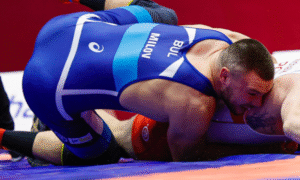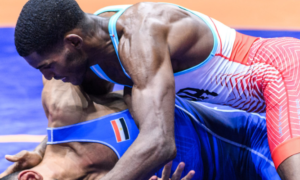Beginning this coming Monday at the South Point Hotel in Las Vegas will be the second World Team camp for the US Seniors, as well as the first collective training camp for the Junior squad. It’s a busy summer, to say the least. After the five-day excursion in Vegas wraps up there will still be two more Senior training camps to go, three if you count their pre-Worlds prep in Hungary. For the Juniors, once work is done in the desert they are to reconvene at the Olympic Training Center where the fun will start all over again, making this first camp for them more of an introductory meeting ground comparatively.
“We have to do some team-building and get the guys to know each other because I think they can feed off of each other’s energy at the World Championships, and that will really help propel them to get on the podium and bring home a team trophy,” said US Junior World Team co-head coach Nate Engel this week. “That’s really important, so you want to make sure they mesh well and get along because we’re going to be spending a lot of time together.”
The Seniors? They’re past the “get to know each other” part of Worlds season. That was taken care of earlier last month in Eagle Creek, Oregon. The “Base Training Camp” was designed to address their positional foundations as well as bring the athletes together on the same proverbial page ahead of their massive training cycle. The upcoming five-day Vegas World Team camp arrives with an acute goal in mind, and it’s one everyone involved might agree offers a poignant value — refining their offensive attacks. To US National Team head coach Matt Lindland, this will be a process predicated upon a two-fold concept: remaining detailed and disciplined, and at the same time, aggressively innovative.
“My philosophy for what I want to see these athletes do, is that first of all, there has to be a good balance between chaos and order,” explains Lindland. “When you step on the mat, the nature of our sport is completely chaotic. It’s a fight, and fights are chaotic. One of my favorite quotes is from Winston Churchill, which says ‘Plans are of little importance, but planning is essential.’ Having a plan is essential in our sport. Knowing that you are taking the fight to your opponent, you’re not waiting and reacting.”
The planning Lindland is referring to requires a little more than for an athlete to just think of a throw or move and attempt its execution. He wants his wrestlers to understand the positions in which certain attacks might prove effective as per their own individual styles while simultaneously observing a systematic approach that lends itself to increased workable attempts. If an athlete is finding success from a position where they can have a go-to attack, then noting the steps it took to get to those positions, how to replicate them, and what’s more, seizing a creative license to expand their attacks, a measure of discipline is required in effort to ensure it all gets locked down into muscle memory.
“It is going to take a lot of discipline, structure, and time to develop your strategy, your plan,” Lindland says. “I want to get these guys really thinking about that and putting it on paper. What that does, is having that discipline and that structure allows the athletes to have a lot of freedom. It really makes sense when you think about it. If you come with a plan and you’re fighting in a chaotic arena, having that structure and discipline allows you to have that freedom to be an artist.”
One of the key reasons Lindland is trumpeting this approach to training has to do with the athletes who represent the current World Team. On paper, and through the observation of each wrestler’s style and history on the Senior circuit, this could be one of the most scoring-friendly squads in recent years. Providing them with the space to expound further on their offensive skill-sets seems like a no-brainer. And in order to cultivate their attacking styles, not to mention their confidence in these attacks, Lindland wants each athlete on the Team to feel free enough to experiment with different ideas so long as there is continual awareness of what it took to get there. It’s why the first camp in Eagle Creek was set up specifically to lay down the positional base, to provide a ground floor that offers a reinforced posture where athletes can feel confident going on the offensive once the whistle blows in Budapest.
“These guys are incredible athletes who we have in our program,” Lindland points out. “They are real martial artists and I want them to create their own art. They have full autonomy and freedom. They need to have discipline in putting their plans together. We have to be disciplined and experiment with different things, try new modalities of getting to our attacks and we have to work through some different scenarios. We go back to what we did in Oregon, which was really just staying in the base longer and building that foundation bigger so that when these guys go to decorate their houses — picking which shades they want, painting, putting different amenities in — is really about freedom and autonomy in forming their own creative plans. They are really creative, they’re artists in their own right, and I don’t want to stifle that. I want to embrace it.”
To top everything off, there will be a collection of cameras adorning the mats at the South Point Hotel next week that will serve a dual purpose. For the athletes in attendance, they are, of course, a useful tool to go back and check out video of items they have been working on throughout the camp. In turn, the coaches can pore over footage to discern adjustments and areas of improvement. In addition, the barrage of high-flying throws and technical shootouts which will undoubtedly also be on display can serve as a reminder to the public just what the country’s top performers are capable of when given a closer look.
“We”ll use the footage to have the athletes go back and watch, and see if there are adjustments that we can point out to help them make,” Lindland says. “I also think with a lot of cameras running that this is an opportunity to market the Greco-Roman program, to show how hard our athletes are training, how hard they are working. Greco-Roman needs that type of an image and we should use it to study to help us get better, but we should also use it to promote our athletes and our program.”
CLICK HERE TO DONATE TO THE USA GRECO-ROMAN PROGRAM
Listen to “5PM18: World Team members Adam Coon and Ellis Coleman” on Spreaker.
SUBSCRIBE TO THE FIVE POINT MOVE PODCAST
iTunes | Stitcher | Spreaker | Google Play Music | RSS
















